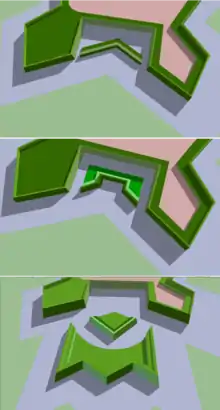Tenaille
A tenaille (archaic tenalia) is an advanced defensive-work, in front of the main defences of a fortress, which takes its name from resemblance, real or imaginary, to the lip of a pair of pincers.[1] It is "from French, literally: tongs, from Late Latin tenācula, pl of tenaculum".[2]

_03_ies.jpg.webp)
In a letter to John Bradshaw, President of the Council of State in London, Oliver Cromwell writing from Dublin on 16 September 1649 described one such tenaille that played a significant part during the storming of Drogheda.
There was a Tenalia to flanker the south Wall of the Town, between Duleek Gate and the corner Tower before mentioned;—which our men entered, wherein they found some forty or fifty of the Enemy which they put to the sword. And this 'Tenalia' they held: but it being without the Wall, and the sally-port through the Wall into that Tenalia being choked up with some of the Enemy which were killed in it, it proved of no use for an entrance into the Town that way. —
— Oliver Cromwell[3]
Tenaille were a development in fortification formalised by Vauban, among others. A postern gate was placed low down in the curtain wall close to the centre in order to allow the defenders to access the ditches that front the wall. To protect the postern, an outwork, originally V-shaped, was placed in front of the gate, providing an area where the defenders could leave the fortification without being seen or directly shot at. A simple tenaille is shown in the top image to the right; it is the chevron between the two corner bastions. The design also evolved a version in which the tenaille possesses projections at each end, as seen in the middle image to the right. The name was also used for some other V-shaped parts of outworks; the bottom-most image, a priest's cap, has two tenailles.[4][5] Also shown is another approach to protect a gate; the roughly triangular outwork seen in the middle of the bottom drawing is a ravelin.
Notes
- Carlyle 1868, p. 381.
- "tenaille", American Heritage Dictionary of the English Language, Fourth Edition. Houghton Mifflin Company.
- Carlyle 1868, pp. 382,383.
- de Vernon 1817, p.46.
- de Vernon 1817, pp. 46–47.
References
- Carlyle, Thomas, ed. (1868), Oliver Cromwell's Letters and Speeches: Includind the Supplement to the First Edition, Harper & brothers
- Attribution
 This article incorporates text from a publication now in the public domain: de Vernon, Simon François Gay; O'Connor, John Michael (translator) (1817), A Treatise on the Science of War and Fortification: Composed for the Use of the Imperial Polytechnick School, and Military Schools; and Translated for the War Department, for the Use of the Military Academy of the United States: to which is Added a Summary of the Principles and Maxims of Grand Tactics and Operations, Printed by J. Seymour
This article incorporates text from a publication now in the public domain: de Vernon, Simon François Gay; O'Connor, John Michael (translator) (1817), A Treatise on the Science of War and Fortification: Composed for the Use of the Imperial Polytechnick School, and Military Schools; and Translated for the War Department, for the Use of the Military Academy of the United States: to which is Added a Summary of the Principles and Maxims of Grand Tactics and Operations, Printed by J. Seymour
| Wikimedia Commons has media related to Tenailles. |